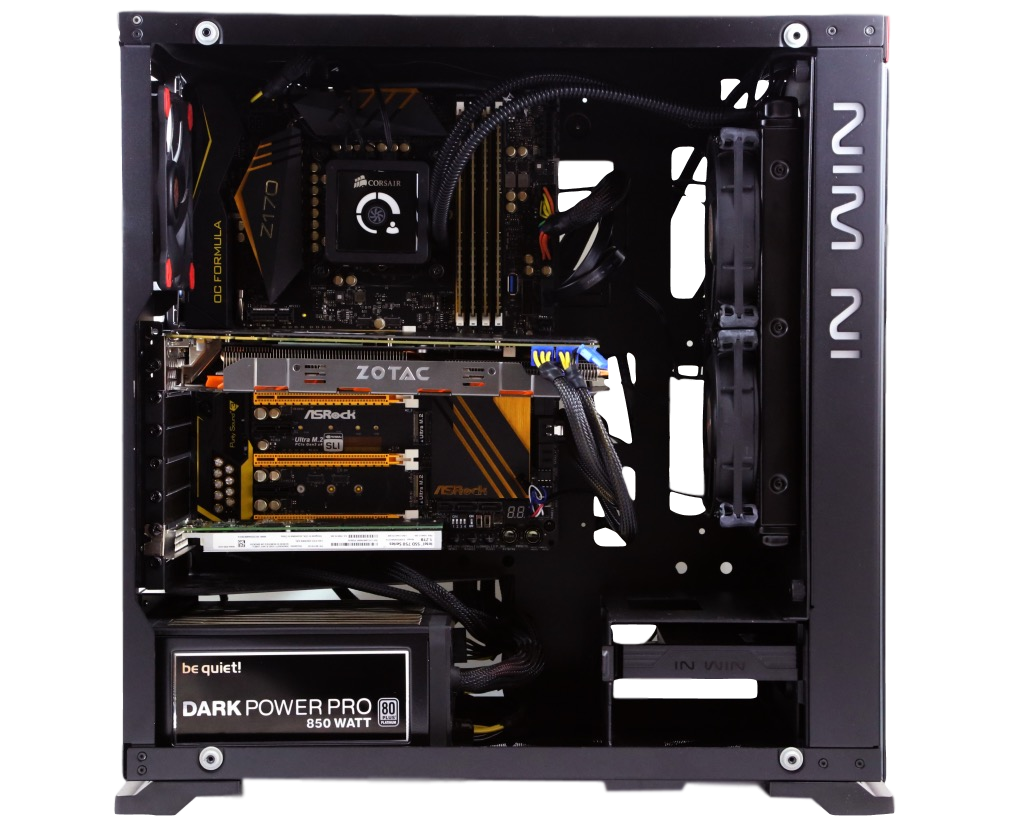THE SSD REVIEW TESTING PROTOCOL
At The SSD Review, we test our storage devices slightly different depending upon the device’s marketed purpose. Our goal is to test in a system that has been optimized with our SSD Optimization Guide, however CPU C State alteration may or may not have occurred depending on the motherboard and BIOS configurations. Benchmarks for our tests are that of fresh devices, so that we can verify that the manufacturer’s specifications match the device. Additionally, we also try to include links to the benchmarks used in our report so that you as the reader can replicate our tests to confirm that your device is top-notch.
SYSTEM COMPONENTS
This Test Bench build was the result of some great relationships and purchases; our appreciation goes to the below mentioned manufacturers for their support in our project. All of the components we use for testing and evaluation can be easily purchased at a relatively affordable price. The links provided below can assist in pricing, as well as availability for those of you who may find interest in our equipment.
| PC Chassis: | In Win 805 Mid Tower Chassis |
| Motherboard: | ASRock Z170 OC Formula |
| CPU: | Intel i5-6600K |
| CPU Cooler: | Corsair H100 AIO CPU Cooler |
| Memory: | Crucial 64GB DDR4-2133 Memory |
| Power Supply: | be quiet! Dark Power Pro 11 850W |
| Graphics Card: | Zotac GeForce GTX 980 Amp! Edition 4GB |
| System Cooling: | be quiet! Silent Wings 2 Chassis Fan |
| Keyboard: | Tesoro Excalibur Spectrum |
| Mouse: | i-rocks M20E Illuminated Gaming Mouse |
| Storage: | Intel 750 Series NVMe PCIe SSD (1.2TB) |
BENCHMARK SOFTWARE
The software in use for today’s analysis is typical of many of our reviews and consists of Piriform Speccy, ATTO Disk Benchmark, Crystal Disk Mark, AS SSD and Anvil’s Storage Utilities. We prefer to test with easily accessible software that the consumer can obtain, and in many cases, we even provide links. Our selection of software allows each to build on the last and to provide validation to results already obtained.
PIRIFORM SPECCY
Piriform Speccy is a great tool for checking the status and health of your computer system. It provides you with brief summary, or a detailed look, at your operating system, CPU, RAM, motherboard, graphics, storage, optical drives, audio, peripherals and network.
As we can see the Lexar microSDXC card is formatted in exFAT, has a real size of 64GB, but a total usable capacity of 59GB, and it does not support SMART attributes, which is common for SD cards and USB devices.
ATTO Disk Benchmark is a relatively easy-to-use benchmark tool, which happens to be the benchmark of choice for many manufacturers. ATTO uses compressible data rather than random data, which results in higher performance and thus, higher benchmark scores. In our testing, we have selected the transfer size to range from 0.5KB to 64MB, and have set the total length of the test to be 256MB.
With our first test, ATTO returns some interesting results. While the read speeds come in anywhere from 30-40MB/s under the listed specifications, the write speeds come in even lower by 60-70MB/s.
 The SSD Review The Worlds Dedicated SSD Education and Review Resource |
The SSD Review The Worlds Dedicated SSD Education and Review Resource | 


most cameras and other dont have UHS-II support. it requires extra interface, so the card is limited to UHS-I in moost appication and this is limited to about 100mb/s .You should rather test this cared against other in high end camera not in windows stupid tools
Woah, those are some pretty expensive cards.
I wish manufacturers would make cards, tuned for random performance. With lots of single board computers floating around without any nand storage, cards like this would be great.
Instead of crazy 100MB/s+ sequential speed, tune the card for low QD at the expense of sequential performance. i’m sure it can be done.